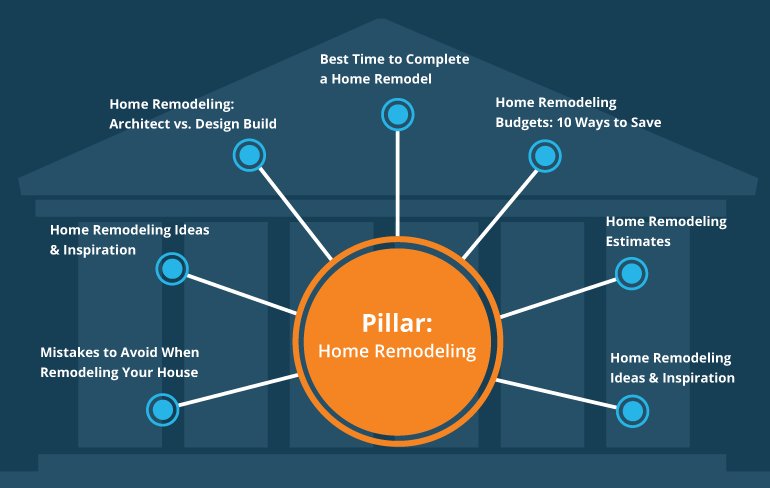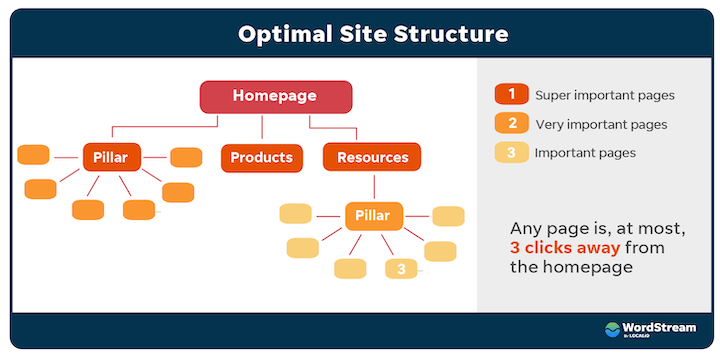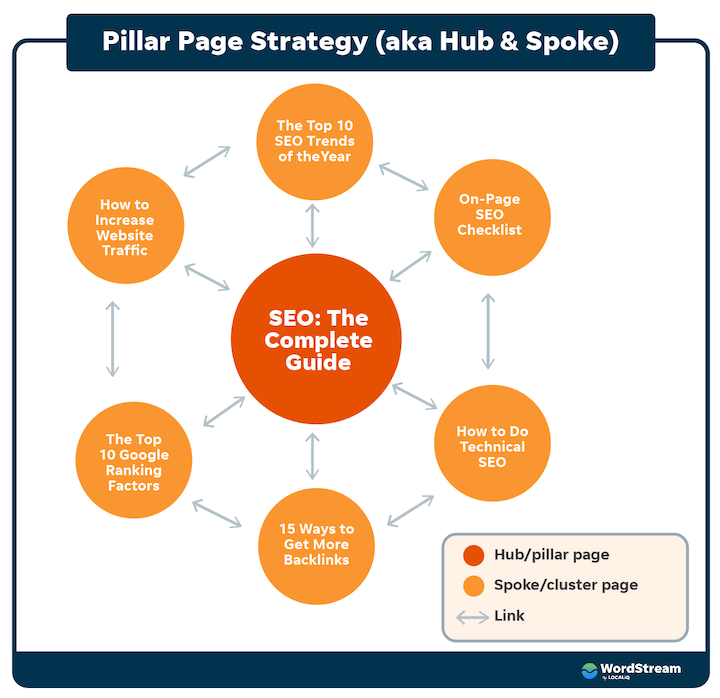Unlock the secrets to SEO success with our comprehensive guide on creating powerful pillar pages to boost your website rankings.

Image courtesy of via DALL-E 3
Table of Contents
- Introduction to Pillar Pages
- Understanding SEO Basics
- Building a Strong Pillar Page
- Connecting Pillar Pages with Cluster Content
- Optimizing Pillar Pages for SEO
- Analyzing and Improving Your Pillar Page
- Successful Examples of Pillar Pages
- Common Mistakes to Avoid
- Conclusion
- Frequently Asked Questions (FAQs)
Introduction to Pillar Pages
In the vast world of the internet, websites compete for attention like players in a game. There’s a special strategy called pillar pages that can help a website score big in the game of online visibility. Think of pillar pages as the strong foundation of a skyscraper that supports and connects all the other floors. In this section, we will explore what a pillar page is and why it’s crucial for SEO success.
What is a Pillar Page?
Imagine you have a favorite book that covers a broad topic from start to finish. Well, a pillar page is like that book on a website. It’s a comprehensive and detailed piece of content that acts as the main hub for a specific subject. Just as the spine holds a book together, a pillar page holds related content on a website. It’s the go-to place for readers looking for everything about a particular topic.
Why Pillar Pages Matter?
Picture searching for a buried treasure. You need a map to guide you to the spot where the treasure lies hidden. When it comes to websites, SEO success is like finding that treasure. A well-structured pillar page acts as that map, leading search engines directly to the valuable information on a website. By creating informative and organized pillar pages, websites become more visible and easier to find in the vast jungle of the internet.
Understanding SEO Basics
SEO stands for Search Engine Optimization. It’s like making your website more attractive so that search engines like Google can easily find and show it to people searching for similar things.
How Do Search Engines Work?
Search engines are like super smart librarians. They have a big collection of websites and when you search for something, they quickly look through all those websites and show you the most helpful ones first. They do this by checking what’s on each website, how many other websites link to it, and even how fast it loads.
By understanding how these search engines work, you can make your website more visible and get more people to visit it!
Building a Strong Pillar Page
When creating a pillar page, the first step is to choose a central topic that will be the focus of your content. It’s important to select a topic that is broad enough to cover multiple subtopics but specific enough to provide valuable and in-depth information to your readers. Think about what your target audience is searching for and tailor your topic to meet their needs and interests.

Image courtesy of codedesign.org via Google Images
Structuring Your Content
Once you have chosen a topic for your pillar page, it’s essential to organize your content in a clear and structured manner. Break down your topic into subtopics or sections that flow logically from one to the next. This will help guide your readers through the information and make it easier for them to digest and understand. Consider using headings, subheadings, bullet points, and visuals to break up the text and make it more engaging.
Connecting Pillar Pages with Cluster Content
When creating a pillar page, it is essential to think about how it connects with other related content on your website. This interlinking strategy can boost your SEO efforts and enhance the overall user experience. Let’s delve into how to effectively connect your pillar pages with cluster content.
What is Cluster Content?
Cluster content is a group of articles or blog posts that revolve around the main topic of your pillar page. These pieces of content provide additional information, detail, and depth to the central subject matter. By organizing your content in clusters, you help search engines better understand the structure of your website and improve your chances of ranking higher in search results.
Creating Cluster Content
When crafting cluster content, ensure that each article or post focuses on a specific aspect or subtopic related to your pillar page. This allows you to cover a wide range of information in-depth, catering to different user search intents. Remember to link back to your pillar page within each cluster piece to establish a clear connection and guide visitors to the core content.
Linking Strategies
Linking your cluster content to the pillar page is crucial for establishing a strong content hierarchy and improving your website’s overall SEO performance. Use internal links strategically by incorporating relevant anchor text that accurately describes the linked content. This not only helps search engines navigate your site but also keeps visitors engaged and encourages them to explore more of your valuable resources.
Optimizing Pillar Pages for SEO
When it comes to creating a pillar page, optimizing it for search engines is crucial to ensure it performs well and reaches its intended audience. By implementing specific strategies, you can enhance the SEO potential of your pillar page and improve its visibility on search engine results pages. Let’s explore some key techniques to optimize your pillar page for SEO.

Image courtesy of www.wordstream.com via Google Images
Using Keywords Effectively
One of the fundamental aspects of SEO optimization is the strategic use of keywords. These are the terms and phrases that people type into search engines when looking for information. Incorporating relevant keywords into your pillar page’s content can help search engines understand what your page is about and rank it accordingly.
When selecting keywords for your pillar page, consider using terms that are closely related to the central topic you are covering. Conduct keyword research to identify popular and relevant keywords in your niche, and then naturally incorporate them into your headings, subheadings, and body content. However, it’s essential to avoid keyword stuffing, as this can negatively impact your page’s ranking.
On-Page SEO Techniques
In addition to using keywords effectively, there are other on-page SEO techniques you can implement to optimize your pillar page. These techniques focus on optimizing individual elements of your page to improve its overall search visibility.
One crucial on-page SEO element is meta tags, including the meta title and meta description. These tags provide search engines with information about your page and can influence its ranking. Craft a compelling meta title that includes your target keyword and accurately describes the content of your pillar page. Similarly, write a concise and enticing meta description that encourages users to click on your page in search results.
Furthermore, optimizing your images with descriptive alt text and file names can improve your page’s accessibility and SEO performance. Ensure that your images are relevant to your content and include alt text that accurately describes the image using keywords where appropriate.
By incorporating these on-page SEO techniques and using keywords effectively, you can optimize your pillar page for search engines and improve its chances of ranking higher in search results.
Analyzing and Improving Your Pillar Page
When it comes to evaluating the performance of your pillar page, there are several tools available to help you gather valuable insights. One essential tool is Google Analytics, which provides data on traffic, user behavior, and more. By analyzing this data, you can determine how well your pillar page is performing and identify areas for improvement.
Making Data-Driven Improvements
It’s crucial to use data to make informed decisions when improving your pillar page. Look at metrics such as bounce rate, time on page, and conversion rates to understand how visitors interact with your content. By analyzing this data, you can make targeted changes to enhance the effectiveness of your pillar page and drive better results.
Successful Examples of Pillar Pages
When it comes to creating effective pillar pages, looking at real-life examples can provide valuable insights into what works. Let’s take a look at some successful pillar pages and see what makes them stand out.

Image courtesy of www.wordstream.com via Google Images
Example 1: Topic Overview
One great example of a successful pillar page can be found on a popular gardening website. This pillar page focuses on the topic of “Growing Your Own Vegetables at Home.” The page covers everything from choosing the right vegetables to plant to nurturing them through the growing process.
The page is structured in a way that makes it easy for readers to navigate and find the information they need. It includes clear headings, subheadings, and bullet points to break up the content and make it more digestible. The use of high-quality images also enhances the overall user experience.
One key strength of this pillar page is its comprehensive approach to the topic. It covers all aspects of home vegetable gardening, providing readers with everything they need to know to get started. The page also includes links to related cluster content, such as specific vegetable growing guides and pest control tips.
Example 2: Detailed Look
Another impressive example of a pillar page can be seen on a renowned fitness website. This pillar page focuses on the topic of “Building Muscle Mass Naturally.” The page is incredibly detailed, covering various aspects of muscle building, including diet, exercise routines, and recovery strategies.
What sets this pillar page apart is its in-depth exploration of the topic. It doesn’t just scratch the surface but delves deep into each subtopic, providing readers with valuable and actionable information. The use of video tutorials and expert interviews further enhances the page’s credibility and engagement.
In addition to the high-quality content, this pillar page excels in its on-page SEO techniques. It strategically incorporates relevant keywords throughout the text, meta descriptions, and image alt tags. The page also includes internal and external links to reputable sources, boosting its authority in the eyes of search engines.
Common Mistakes to Avoid
Missing the Main Topic
One of the most common mistakes to avoid when creating a pillar page is not honing in on a central subject. It’s essential to choose a specific topic that your pillar page will revolve around. Without a clear focus, the page can become convoluted and fail to provide valuable information to your readers. Remember, the pillar page should act as a comprehensive guide on a particular subject, serving as a foundational piece of content for your website.
Poor Linking Structure
Another critical error to steer clear of is having a poor linking structure within your pillar page and its associated cluster content. Links play a vital role in guiding both users and search engine crawlers through your website. If the links are broken, irrelevant, or disorganized, it can hinder the user experience and impact the overall SEO performance of your content. Ensure that your pillar page is strategically linked to your cluster content, making it easy for visitors to navigate and discover related information seamlessly.
Conclusion
In this blog post, we have explored the essential framework for creating successful pillar pages that can significantly impact your website’s SEO performance. Let’s recap the key points discussed:

Image courtesy of theblogpilot.com via Google Images
Recapping the Importance of Pillar Pages
Pillar pages serve as the central hub of content on a specific topic, providing valuable information to both visitors and search engines. By creating well-structured pillar pages, you can improve your website’s visibility and ranking on search engine results pages.
Final Tips
As you embark on creating your own pillar pages, remember to choose topics that are relevant to your target audience and align with your overall SEO strategy. Ensure your content is well-organized, informative, and engaging to keep visitors on your site. Regularly analyze and make improvements to your pillar pages based on data insights to enhance their performance continuously.
By following the guidelines outlined in this blog post and putting in the effort to create strong pillar pages, you can establish a solid foundation for your website’s SEO success. Start building your pillar pages today and watch your online visibility soar!
Want to turn these SEO insights into real results? Seorocket is an all-in-one AI SEO solution that uses the power of AI to analyze your competition and craft high-ranking content.
Seorocket offers a suite of powerful tools, including a Keyword Researcher to find the most profitable keywords, an AI Writer to generate unique and Google-friendly content, and an Automatic Publisher to schedule and publish your content directly to your website. Plus, you’ll get real-time performance tracking so you can see exactly what’s working and make adjustments as needed.
Stop just reading about SEO – take action with Seorocket and skyrocket your search rankings today. Sign up for a free trial and see the difference Seorocket can make for your website!
Frequently Asked Questions (FAQs)
How Long Should a Pillar Page Be?
A pillar page should be comprehensive and cover the central topic in-depth. It is recommended to aim for a word count of around 2,000 to 5,000 words, depending on the complexity of the subject. However, the focus should be on providing valuable information to the reader rather than just meeting a specific word count.
Can You Have More Than One Pillar Page?
Yes, a website can have multiple pillar pages, each focusing on a different core topic or category relevant to the business or industry. Having multiple pillar pages allows for a broader coverage of key subjects and helps organize the website’s content in a more structured manner. Ensure that each pillar page is distinct and serves a specific purpose in addressing different aspects of the business or industry.







